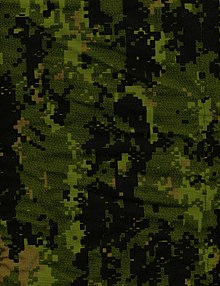| Canadian Disruptive Pattern | |
|---|---|
 CADPAT temperate woodland pattern | |
| Type | Military camouflage pattern |
| Place of origin | Canada |
| Service history | |
| In service | 1997–present |
| Used by | Canadian Armed Forces |
| Wars | Operation Enduring Freedom (2001–14) |
| Production history | |
| Produced | 1995–present |
| Variants |
|
The Canadian Disruptive Pattern[2] (CADPAT; French: dessin de camouflage canadien, DcamC[3]) is the computer-generated digital camouflage pattern developed for use by the Canadian Armed Forces. Four operational variations of CADPAT have been used by the Canadian Armed Forces: a temperate woodland pattern, an arid regions pattern, a winter operations pattern, and a multi-terrain pattern.
CADPAT was the first digital camouflage pattern to be used operationally, having been issued in 1997 with the Canadian Armed Forces. The pattern became fully standardized within the Canadian Armed Forces by 2002, having completely replaced the olive-drab operational uniforms formerly used by Regular Force units. The multi-terrain CADPAT variant began development in 2019, and is planned to replace the temperate woodland and arid regions CADPAT variations.
- ^ "Requesting the Commercial Use of the Canadian Disruptive Pattern". Government of Canada. 28 September 2020. Retrieved 27 July 2022.
- ^ https://hyperstealth.com/CADPAT/
- ^ https://www.canada.ca/fr/ministere-defense-nationale/feuille-derable/defense/2020/03/dcamc-un-developpement-unique-au-canada.html